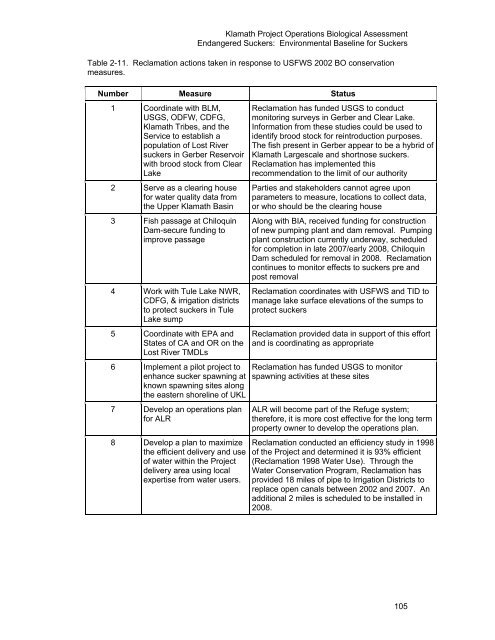Our new Biological Assessment is out - Klamath Basin Crisis
Our new Biological Assessment is out - Klamath Basin Crisis
Our new Biological Assessment is out - Klamath Basin Crisis
Create successful ePaper yourself
Turn your PDF publications into a flip-book with our unique Google optimized e-Paper software.
<strong>Klamath</strong> Project Operations <strong>Biological</strong> <strong>Assessment</strong><br />
Endangered Suckers: Environmental Baseline for Suckers<br />
Table 2-11. Reclamation actions taken in response to USFWS 2002 BO conservation<br />
measures.<br />
Number Measure Status<br />
1 Coordinate with BLM,<br />
USGS, ODFW, CDFG,<br />
<strong>Klamath</strong> Tribes, and the<br />
Service to establ<strong>is</strong>h a<br />
population of Lost River<br />
suckers in Gerber Reservoir<br />
with brood stock from Clear<br />
Lake<br />
2 Serve as a clearing house<br />
for water quality data from<br />
the Upper <strong>Klamath</strong> <strong>Basin</strong><br />
3 F<strong>is</strong>h passage at Chiloquin<br />
Dam-secure funding to<br />
improve passage<br />
4 Work with Tule Lake NWR,<br />
CDFG, & irrigation d<strong>is</strong>tricts<br />
to protect suckers in Tule<br />
Lake sump<br />
5 Coordinate with EPA and<br />
States of CA and OR on the<br />
Lost River TMDLs<br />
6 Implement a pilot project to<br />
enhance sucker spawning at<br />
known spawning sites along<br />
the eastern shoreline of UKL<br />
7 Develop an operations plan<br />
for ALR<br />
8 Develop a plan to maximize<br />
the efficient delivery and use<br />
of water within the Project<br />
delivery area using local<br />
expert<strong>is</strong>e from water users.<br />
Reclamation has funded USGS to conduct<br />
monitoring surveys in Gerber and Clear Lake.<br />
Information from these studies could be used to<br />
identify brood stock for reintroduction purposes.<br />
The f<strong>is</strong>h present in Gerber appear to be a hybrid of<br />
<strong>Klamath</strong> Largescale and shortnose suckers.<br />
Reclamation has implemented th<strong>is</strong><br />
recommendation to the limit of our authority<br />
Parties and stakeholders cannot agree upon<br />
parameters to measure, locations to collect data,<br />
or who should be the clearing house<br />
Along with BIA, received funding for construction<br />
of <strong>new</strong> pumping plant and dam removal. Pumping<br />
plant construction currently underway, scheduled<br />
for completion in late 2007/early 2008, Chiloquin<br />
Dam scheduled for removal in 2008. Reclamation<br />
continues to monitor effects to suckers pre and<br />
post removal<br />
Reclamation coordinates with USFWS and TID to<br />
manage lake surface elevations of the sumps to<br />
protect suckers<br />
Reclamation provided data in support of th<strong>is</strong> effort<br />
and <strong>is</strong> coordinating as appropriate<br />
Reclamation has funded USGS to monitor<br />
spawning activities at these sites<br />
ALR will become part of the Refuge system;<br />
therefore, it <strong>is</strong> more cost effective for the long term<br />
property owner to develop the operations plan.<br />
Reclamation conducted an efficiency study in 1998<br />
of the Project and determined it <strong>is</strong> 93% efficient<br />
(Reclamation 1998 Water Use). Through the<br />
Water Conservation Program, Reclamation has<br />
provided 18 miles of pipe to Irrigation D<strong>is</strong>tricts to<br />
replace open canals between 2002 and 2007. An<br />
additional 2 miles <strong>is</strong> scheduled to be installed in<br />
2008.<br />
105










